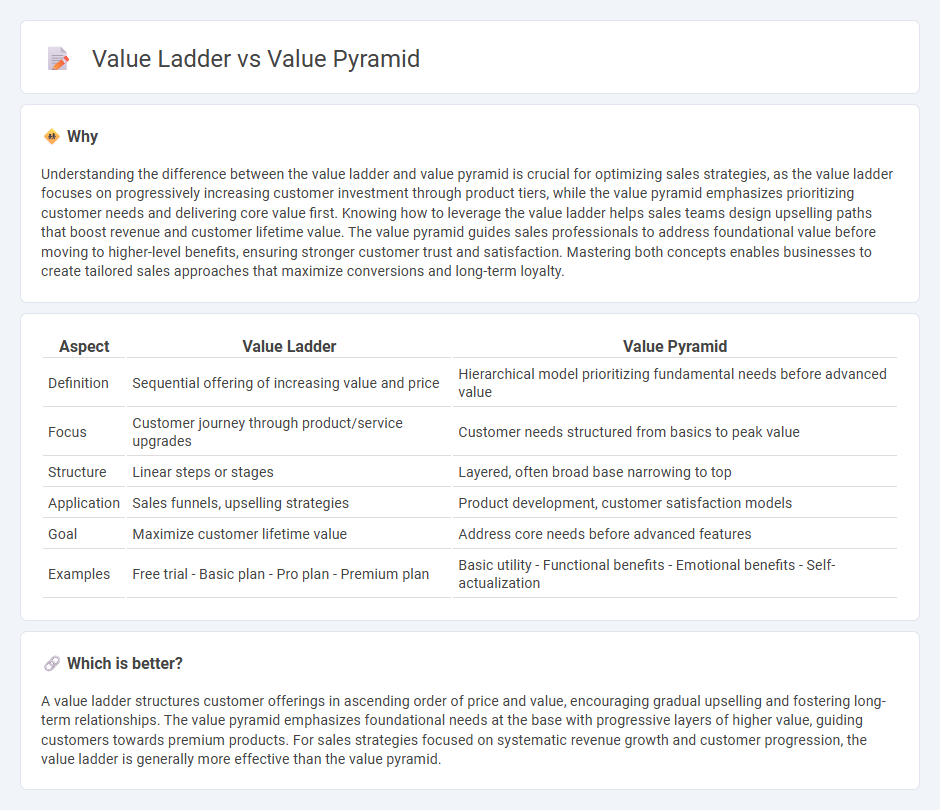
The value ladder and value pyramid are strategic frameworks used in sales to optimize customer engagement and maximize revenue. The value ladder focuses on progressively increasing product or service value through ascending price points, while the value pyramid emphasizes prioritizing customer needs and benefits in a hierarchical structure. Explore these models to uncover effective methods for enhancing your sales strategy and driving growth.
Why it is important
Understanding the difference between the value ladder and value pyramid is crucial for optimizing sales strategies, as the value ladder focuses on progressively increasing customer investment through product tiers, while the value pyramid emphasizes prioritizing customer needs and delivering core value first. Knowing how to leverage the value ladder helps sales teams design upselling paths that boost revenue and customer lifetime value. The value pyramid guides sales professionals to address foundational value before moving to higher-level benefits, ensuring stronger customer trust and satisfaction. Mastering both concepts enables businesses to create tailored sales approaches that maximize conversions and long-term loyalty.
Comparison Table
| Aspect | Value Ladder | Value Pyramid |
|---|---|---|
| Definition | Sequential offering of increasing value and price | Hierarchical model prioritizing fundamental needs before advanced value |
| Focus | Customer journey through product/service upgrades | Customer needs structured from basics to peak value |
| Structure | Linear steps or stages | Layered, often broad base narrowing to top |
| Application | Sales funnels, upselling strategies | Product development, customer satisfaction models |
| Goal | Maximize customer lifetime value | Address core needs before advanced features |
| Examples | Free trial - Basic plan - Pro plan - Premium plan | Basic utility - Functional benefits - Emotional benefits - Self-actualization |
Which is better?
A value ladder structures customer offerings in ascending order of price and value, encouraging gradual upselling and fostering long-term relationships. The value pyramid emphasizes foundational needs at the base with progressive layers of higher value, guiding customers towards premium products. For sales strategies focused on systematic revenue growth and customer progression, the value ladder is generally more effective than the value pyramid.
Connection
The value ladder and value pyramid both illustrate progressive stages of customer value and engagement, with the value ladder focusing on increasing product or service offerings while the value pyramid emphasizes hierarchical needs fulfillment. Businesses leverage the value ladder to guide customers from basic to premium offerings, aligning with the value pyramid's progression from foundational benefits to emotional and self-fulfillment needs. Integrating these frameworks enhances sales strategies by ensuring products not only escalate in price and features but also resonate deeper with customer motivations and priorities.
Key Terms
Hierarchy of Needs
The value pyramid and value ladder both represent customer journey frameworks rooted in Maslow's Hierarchy of Needs, emphasizing progression from basic to advanced value offerings. The value pyramid arranges product or service benefits hierarchically, starting with functional needs, advancing through emotional and self-fulfillment levels, whereas the value ladder illustrates step-by-step stages of increasing value through upsells and enhanced customer experiences. Explore the nuances of how each model leverages psychological needs to maximize customer engagement and satisfaction.
Customer Perceived Value
The value pyramid emphasizes hierarchical customer perceived value, starting from basic functional benefits and advancing to emotional and self-expressive benefits, highlighting the depth of customer satisfaction. The value ladder, in contrast, focuses on a sequential progression of product or service offerings that increase in value, price, and customer commitment, enhancing the overall buyer journey. Explore more to understand how these concepts drive strategic customer engagement and loyalty.
Offer Structuring
The value pyramid emphasizes hierarchical customer needs, guiding offer structuring from basic to advanced product features that fulfill foundational to aspirational desires. The value ladder prioritizes sequential upselling, structuring offers to progressively increase customer investment through escalating benefits and price points. Explore these models further to strategically design offers that maximize customer value and revenue.
Source and External Links
Business Value Pyramid - Agile Brand Guide - The Business Value Pyramid organizes initiatives from foundational functional elements (efficiency, compliance) through emotional (attractiveness, wellness) and life-changing (motivation, belonging) to transformational social impact at the top, guiding businesses to prioritize by strategic value.
The Elements of Value - Marketing Journal - This Value Pyramid framework starts with objective, functional value (cost reduction, scalability), moves to emotional and relationship-based benefits (design, reduced anxiety), and peaks with inspirational elements like hope, vision, and social responsibility, helping companies differentiate beyond basic utility.
The Values Pyramid: A Hierarchy of Core Values - The Values Pyramid progresses from foundational values (security, competence) to Impact (status, influence) and culminates in Fulfillment (meaning, gratitude, connection to something greater), illustrating how personal values evolve as each foundational layer is secured.
 dowidth.com
dowidth.com